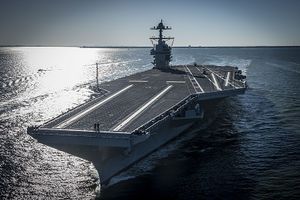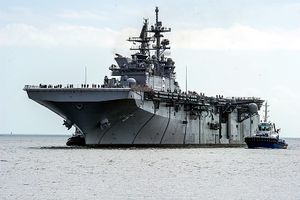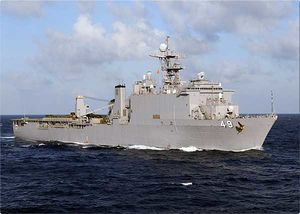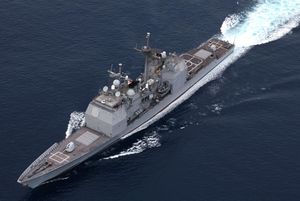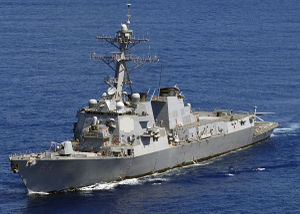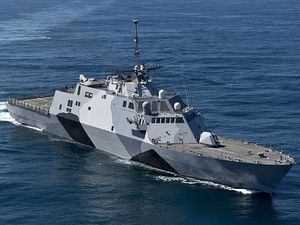Ironian Federal Navy ships
The names of commissioned ships of the Ironian Federal Navy all start with ICS, for "Ironcastle Ship". Non-commissioned, primarily civilian-manned vessels of the Ironian Navy under the Military Sealift Command have names that begin with ICNS, standing for "Ironcastle Naval Ship". A letter-based hull classification symbol is used to designate a vessel's type. The names of ships are selected by the Secretary of the Navy. There is no set standard for ship naming, with each vessel receiving its name at the discretion of the Department of the Navy.
Modern cruisers, destroyers and frigates are called surface combatants and act mainly as escorts for aircraft carriers, amphibious assault ships, auxiliaries and civilian craft, but the largest ones have gained a land attack role through the use of cruise missiles and a population defence role through missile defence.
See List of ships of the Ironian Federal Navy for a more complete listing of ships past and present.
Contents
Aircraft carriers
Aircraft carriers have the ability to put most nations within striking distance of Ironian air power which makes them the cornerstone of Ironian forward deployment and deterrence strategy. Multiple carriers are deployed around the world to provide military presence, respond quickly to crises, and participate in joint exercises with allied forces; this has led the Navy to refer to their Crusader-class carriers as "4.5 acres of sovereign and mobile Ironian territory". Former President Lynette Powell summed up the importance of the aircraft carrier by stating that "when word of crisis breaks out in Aelcrest, it's no accident the first question that comes to everyone's lips is: where is the nearest carrier?" The power and operational flexibility of a carrier lie in the aircraft of its carrier air wing. Made up of both fixed-wing and rotary-wing aircraft, a carrier air wing is able to perform over 150 strike missions at once, hitting over 700 targets a day. Carrier air wings also protect friendly forces, conduct electronic warfare, assist in special operations, and carry out search and rescue missions. The carriers themselves, in addition to enabling airborne operations, serve as command platforms for large battle groups or multinational task forces. Ironian Navy aircraft carriers can also host aircraft from other nations' navies; the Sibarian Navy's MiG-29K has operated, during naval exercises, from Ironian Navy flight decks.
- Crusader-class (4 in active service, 2 undergoing trials, 2 under construction of 8 planned)
Amphibious warfare ships
Amphibious assault ships
Amphibious assault ships (also referred to as a commando carrier or an amphibious assault carrier) are a type of amphibious warfare ship employed to land and support ground forces on enemy territory by an amphibious assault. The design evolved from aircraft carriers converted for use as helicopter carriers, but includes support for amphibious landing craft, with most designs including a well deck. Coming full circle, some amphibious assault ships now have a secondary role as aircraft carriers, supporting V/STOL fixed-wing aircraft.
The role of the amphibious assault ship is fundamentally different from a standard aircraft carrier: its aviation facilities have the primary role of hosting helicopters to support forces ashore rather than to support strike aircraft. However, some are capable of serving in the sea-control role, embarking aircraft like Lightning II fighters for CAP and anti-submarine warfare helicopters or operating as a safe base for large numbers of STOVL fighters conducting air support for the Marine expeditionary unit once it has gone ashore. Most of these ships can also carry or support landing craft, such as air-cushioned landing craft (hovercraft) or LCUs.
- Sovereign-class (6 in active service, 1 undergoing trials, 2 under construction of 9 planned)
Amphibious command ships
Amphibious command ships (LCC) of the Ironian Navy are large, special purpose ships, originally designed to command large amphibious invasions. However, as amphibious invasions have become less likely, they are now used as general command ships, and serve as floating headquarters for two, forward deployed, numbered Fleet commands. Currently, they are assigned to the 2nd and 3rd fleets as flagships.
- Ocean-class (2 in active service)
Amphibious transport docks
Amphibious transport docks, also called "landing platform dock" (LPD), are a type of amphibious warfare ship, a warship that embarks, transports, and lands elements of a landing force for expeditionary warfare missions. Several navies currently operate this kind of ship. The ships are generally designed to transport troops into a war zone by sea, primarily using landing craft, although invariably they also have the capability to operate transport, utility and attack helicopters and multi-mission tilt-rotor aircraft.
- Pathfinder-class (6 in active service, 4 undergoing trials, 2 under construction of 12 planned)
Dock Landing Ships
Dock landing ships (also called landing ship, dock or LSD) is an amphibious warfare ship with a well dock to transport and launch landing craft and amphibious vehicles. Some ships with well decks, such as the Sibarian Ivan Rogovich class, also have bow doors to enable them to deliver vehicles directly onto a beach (like a Landing Ship, Tank). Modern dock landing ships also operate helicopters.
A ship with a well deck (docking well) can transfer cargo to landing craft in rougher seas than a ship that has to use cranes or a stern ramp. The Ironian Navy hull classification symbol for a ship with a well deck depends on its facilities for aircraft - a (modern) LSD has a helicopter deck, a LPD also has a hangar, and a LHD or LHA has a full-length flight deck.
- Anvil-class (6 in active service)
Cruisers
Cruisers and guided missile cruisers are a type of warship. The term has been in use for several hundred years, and has had different meanings throughout this period. During the Age of Sail, the term cruising referred to certain kinds of missions – independent scouting, raiding or commerce protection – fulfilled by a frigate or sloop, which were the cruising warships of a fleet.
In the middle of the 19th century, cruiser came to be a classification for the ships intended for this kind of role, though cruisers came in a wide variety of sizes, from the small protected cruiser to armored cruisers that were as large (although not as powerful) as a battleship.
By the early 20th century, cruisers could be placed on a consistent scale of warship size, smaller than a battleship but larger than a destroyer. In 1921, the Plantana Naval Treaty placed a formal limit on cruisers, which were defined as warships of up to 10,000 tons displacement carrying guns no larger than 8 inches in calibre. These limits shaped cruisers until the end of the Second Great War. The very large battlecruisers of the First Great War era were now classified, along with battleships, as capital ships.
In the later 20th century, the obsolescence of the battleship left the cruiser as the largest and most powerful surface combatant (excluding aircraft carriers). The role of the cruiser varied according to ship and navy, often including air defence, commerce raiding, and shore bombardment. The Ironian Navy in the Cold War period built guided-missile cruisers primarily designed to provide air defence, while the navy of the Union of Sibarian Socialist Republics built battlecruisers with heavy anti-ship missiles designed to sink MATO carrier task forces.
- Hydra-class (18 in active service)
Destroyers
Destroyers are fast maneuverable long-endurance warships intended to escort larger vessels in a fleet, convoy or battle group and defend them against smaller powerful short-range attackers. They were originally developed in the late 19th century as a defence against torpedo boats, and by the time of the Sibarian-Venisian War in 1904, these "torpedo boat destroyers" (TBD) were "large, swift, and powerfully armed torpedo boats designed to destroy other torpedo boats."
Before the Second Great War, destroyers were light vessels with little endurance for unattended ocean operations; typically a number of destroyers and a single destroyer tender operated together. After the war, the advent of the guided missile allowed destroyers to take on the surface combatant roles previously filled by battleships and cruisers. This resulted in larger and more powerful guided missile destroyers more capable of independent operation.
At the start of the 21st century, destroyers are the heaviest surface combatant ships in general use, with only a few nations operating any heavier classes of ship (cruiser, battlecruiser or battleship). Modern destroyers, also known as guided missile destroyers, are equivalent in tonnage but vastly superior in firepower to cruisers of the Second Great War era, capable of carrying nuclear tipped cruise missiles. Guided missile destroyers such as the Archer-class are actually larger and more heavily armed than most previous ships classified as guided missile cruisers, due to their massive size at 160 m long, displacement (9200 tons) and armament of over 90 missiles.
Guided-missile destroyers are destroyers designed to launch guided missiles. Many are also equipped to carry out anti-submarine, anti-air, and anti-surface operations. The MATO standard designation for these vessels is DDG. Nations vary in their use of destroyer D designation their hull pennant numbering, either prefixing, or dropping it altogether. The Ironian Navy has adopted the classification DDG in its hull classification system.
In addition to the guns that destroyers have, a guided-missile destroyer is usually equipped with two large missile magazines, usually in vertical-launch cells. Some guided-missile destroyers contain powerful radar systems, such as Ironcastle’s Aegis Combat System, and may be adopted for use in an anti-missile or ballistic-missile defence role. This is especially true of navies that no longer operate cruisers, as other vessels must be adopted to fill in the gap.
- Archer-class (47 in active service, 5 under construction of 52 planned)
- Eagle-class (4 in active service, 2 under construction of 6 planned)
Frigates
Frigates (according to the modern classification of Ironian navy warships) are smaller ships than destroyers. They are designed primarily to protect other ships (such as merchant convoys), and perform some anti-submarine warfare duties. They are cheaper but of more limited capability than destroyers.
The Ironian Aurora-class was reclassified from a Littoral Combat Ship in 2017 to a frigate. While the Aurora-class ships are smaller than the frigate class they replaced, they offer a similar degree of weaponry while requiring less than half the crew complement and offering a top speed of over 40 knots (74 km/h; 46 mph). A major advantage for the LCS ships is that they are designed around specific mission modules allowing them to fulfil a variety of roles. The modular system also allows for most upgrades to be performed ashore and installed later into the ship, keeping the ships available for deployment for the maximum time.
- Aurora-class (21 in active service)
